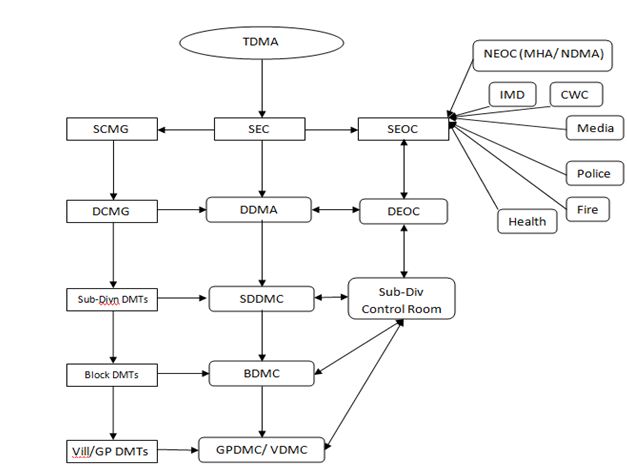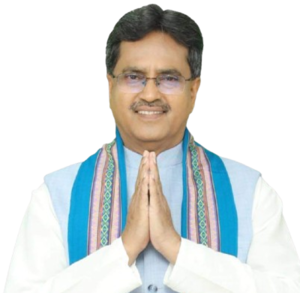Disaster Management
Disaster Management System
Tripura is vulnerable to Earthquakes, Floods, Landslides, Cyclones, extended dry spells and other natural and human induced disasters. The State is very vulnerable to earthquakes as it is situated on Seismic Zone-V and has higher probability of occurrence of big earthquakes measuring Richter scale 8 and more. The State has witnessed the great earthquakes in 1897 and 1950 measuring Richter scale above 8. During 1897 earthquake, the Ujjayanta Palace in Agartala was fully damaged. In recent past, the State also witnessed a moderate earthquake of magnitude of 5.7 on the Richter Scale with epicentre in Dhalai district on 3rd January, 2017.
Floods are recurrent and have potential for disaster in the State. They occur every year during normal monsoon season and cause temporary floods in valley and plain-lands, and urban flooding in Agartala and other ULBs. However due to apparent accentuated climate change risks, the floods are occurring beyond monsoon season. The last devastating floods occurred in the State during 2018 wherein all districts were affected and the State incurred a loss of about Rs.1300 Crore including all sectors.
So far as Cyclone vulnerability is concerned, wind speed in the State can go upto 55m/s (198km/h) which are occasionally reached when cyclonic winds reach the State after crossing Bangladesh. It also affects the State during “KalBaishakhi” (April-May) of every year. Damage to the houses, infrastructures such as power, roads and bridges have been reported as very high besides damages to the agriculture and forest sectors.
Tripura also suffers landslides during monsoon specially on the national highway- the life line of Tripura.Tripura’s vulnerability to lightningand thunder strikes is also moderate to high intensity and these events also cause heavy loss of lives in the State.
As per the Disaster Management Act, 2005, Government of Tripura has constituted the SDMA, SEC, DDMA, SDRF, EOC, procured various critical equuipments, developed the Disaster Management Plans, identified nodal training institutes and other need-based institutions and establishments. The State Government is also implementing various projects and schemes as per the need of the State in coordination with Central Government and line Departments. The Finance Commission award towards State Disaster Response Fund and State Disaster Mitigation Funds are also being used for effective implementation of disaster management activities in the State.
Disaster Management activities undertaken in Tripura
- Institutional Framework:

- Tripura Disaster Management Authority (TDMA) chaired by the Hon’ble Chief Minister is the apex body in the State.
- State Executive Committee (SEC) chaired by the Chief Secretary is the implementing body of Disaster Management Activities in the State.
- District Disaster Management Authority (DDMA) is the implementing body in the District. DDMA meetings are held on half yearly basis. Disaster Management Committees constituted at sub-division, block and GP/Village levels.
- The State Crisis Management Group (SCMG) and District Crisis Management Groups (DCMGs) have been constituted for handling man-made disasters and linked up with the SEC and DDMAs respectively.
- For maintaining uniform command during disaster situation, incident commanders have been identified at State, District and Sub-division level (Chief Secretary-State level; DM & Collector-District level and Sub Divisional Magistrate at Sub-division level).
- Disaster Management Plan at District, Sub-division, Block, Panchayats/ Villages have been prepared and updated annually.
- Disaster Management Plans also prepared for line departments, school levels and for the New Capital Complex Secretariat building.
- Standard Operating Procedures (SOPs) have been prepared for functioning of Control Rooms, Handling Equipments, Conducting Mock Drills, for Search & Rescue Operations.
2. Operation of Control Room/ Emergency Operation Centres (EOC):
- The state has 24x7 State and District Control Rooms (EOCs) functioning round the clock in the Secretariat and DM & Collectors Offices respectively.
- State EOC receives daily weather information / warnings from IMD and CWC and shares to the District EOCs. Daily situation report is being issued at 5PM.
- Toll Free telephones are working in State EOC (1070) and District EOCs (1077).
- Doppler Rader at IMD-Agartala station is being linked with State EOC for sharing now casting (warning of severe thunder storm, cyclones before one hour of the incident).
- HAM Radio Stations have been installed in State Emergency Operation Centre (SEOC) and 8 District Emergency Operation Centres (DEOCs).
- Emergency Response Support System (ERSS) -112 has been extended to State Emergency Operation Centre (SEOC).
- Common Alerting Protocol (CAP) system is operational. Through CAP early warning related to weather is disseminated to mobile user through SMS.
- The recent initiatives of Disaster Management in the State:
- As per the Disaster Management Act 2005, Tripura Disaster Management Authority (TDMA), State Executive Committee and District Disaster Management Authorities have been setup. TDMA has been restructured by putting subject specialists.
- For disaster command, control, coordination and communication, Emergency Operation Centres (EOCs) are functioning on 24x7 basis at State and District Hqs. 1070 is the toll-free no for State EOC and 1077 is for District EOCs. Now the State EOC is being upgraded to ERSS-112.
- For disaster response, there is one permanent NDRF platoon at CTI-Gokulnagar and one temporary NDRF team stationed at Kailashahar for the monsoon season since 2018 floods.
- State Govt. has raised 4 Coys of State Disaster Response Force (SDRF) in the line of NDRF.
- Civil Defence setup is now under the administrative control of Revenue Department. The Director RR&DM is the Director of Civil Defence. All Districts have been declared as the Civil Defence Districts and the ADM & Collectors is the Controller of Civil Defence of the District Civil Defence Corps.
- As per Govt. decision, 1% of State population will be trained as Civil Defence Volunteers and so far3000 Civil Defence volunteers have been trained in phases.
- Upscaling Aapda Mitra Volunteers Scheme is being implemented in the State. It’s a centrally sponsored scheme in which 800 Aapda Mitra volunteers will be trained in 7 districts except Sepahijala @200 from West Tripura and @100 from other six districts. Now, total trained Aapda Mitra volunteers have been trained in the State stands at 1000.
- Sepahijala district has already been implemented the Aapda Mitra Scheme during 2017-19 wherein 200 Aapda Mitra Volunteers have been trained and now being used by administration.
- HAM radio has been considered as one of the alternate communication systems in disaster management. For this, the State Govt. has decided to setup 9 HAM radio stations in all 8 districts and State. The first HAM station at SEOC campus, Agartala is ready for inauguration soon.
- So far more than 1500 officials and volunteers have been trained on HAM radio operation.
- For HAM radio operation, it is necessary to have HAM licence that issued by Ministry of Communication, Govt. of India. So far the State has already more than 400 HAM licensed officials and volunteers who will be used for disaster management.
- Fire Service Department has been renamed as Fire & Emergency Services Department and being strengthened to cater to various disasters.
- For providing equipment support for emergency rescue operations the State Govt. has procured 45 types of critical equipments and positioned at all 23 sub-divisions, 12 TSR Bns, CTI-Gokulnagar and District Hqs. Few critical equipments are motor boats, life detectors, satellite phones, drones, night vision equipment, cutters, firefighting and lighting equipments, tents, stretchers, ambulances etc.
- For handing drowning cases, State Government has taken initiative for procurement of equipments and training to officials. Further, initiative is being taken for procurement of additional advanced equipment and train more officials and volunteers.
- Besides disasters that identified by Govt. of India, State Govt. has declared 11 disasters as State Specific Disasters for extending benefits to the affected people in the state.
|
Central |
State Specific |
|
1.Avalanches |
1. Lightening/ Thundering |
|
2.Cyclone |
2. Fire in shops and houses (except riot, political violence & intentional/insured) |
|
3.Cloud burst |
3. Erosion (River Bank, Land etc. due to flow of flood water) |
|
4.Drought |
4. Heavy Rain |
|
5.Earthquake/ Tsunami |
5. Storm |
|
6.Fire |
6. Strong Wind |
|
7.Flood |
7. Heat Wave |
|
8.Hailstorm |
8. Sun Burn |
|
9.Landslide |
9. Sun Stroke |
|
10.Pest Attack |
10. Drowning in rivers, ponds, deep hole, lakes (except suicide or intentional) |
|
11.Frost and Cold Wave |
11. Mass tragedy/accidents i.e. road accidents, rail accidents, air accidents, boat tragedy, gas leakage, poisoning etc |
|
|
12. Wild Animal Attack |
|
|
13. Forest Fire |
- For early warning system, there are provisions of weather forecast, nowcast, lightning early warning, mobile apps (bhookamp, damini, mausam, meghdoot), Common Alerting Protocol (CAP) etc. Various Whatsapp groups have been created at State and Dist levels for dissemination of warnings and disaster related information.
- Recently IMD, Govt. of India has approved additional 10 Automated Rain Gauges which will be installed in Agartala and other urban areas. Also additional 7 Automated Weather Stations which will be installed in strategic locations in the State. These instruments will provide weather early warning inputs.
- Central Water Commission is now setting up of additional 7 flood forecasting stations in Gumti, Haora, Khowai and Dhalai rivers.
- A special project is being implemented for river embankment studies for Manu and Haora rivers with technical support from North East Space Application Centre (NESAC), Shillong.
- For lightning safety activities, about 200 officials and volunteers have been trained on how to develop improvised lightning arresters and they are now creating awareness, preparing the arresters and installing in vulnerable areas.
- For earthquake risk management, a project is being implemented for retrofitting of critical buildings, training of engineers and masons, construction of TDU and awareness generation.
- All DMs and SDMs have adequate fund for responding to any disaster situation immediately.
- 13 October is the International Day for Disaster Risk Reduction (IDDRR) day and it is being observed with various awareness and capacity building activities in the State and districts.
- School level evacuation drill for earthquake disaster is conducted on every 3rd Saturday.
- Education Department is implementing school safety programme and major activities are training to students and teachers, preparation of DM plans, mock exercises etc.
- Central Training Institute (CTI), Gokulnagar is the nodal training centre for disaster management for uniformed personnel, key officials and community volunteers.
- HAM Radio Stations have been installed in State Emergency Operation Centre (SEOC) and 8 District Emergency Operation Centre (DEOCs) and 3 repeater stations established in Dhalai, West Tripura and Gomati District.

